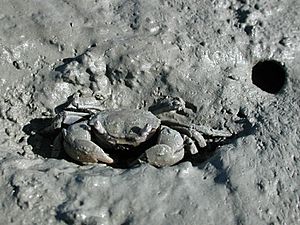Tunnelling mud crab facts for kids
Quick facts for kids Tunnelling mud crab |
|
|---|---|
 |
|
| Scientific classification | |
| Kingdom: | |
| Phylum: | |
| Subphylum: | |
| Class: | |
| Order: | |
| Suborder: |
Pleocyemata
|
| Infraorder: | |
| Family: |
Varunidae
|
| Genus: |
Austrohelice
K. Sakai, Türkay & Yang, 2006
|
| Species: |
A. crassa
|
| Binomial name | |
| Austrohelice crassa (Dana, 1851)
|
|
| Synonyms | |
|
|
The tunnelling mud crab, also known as Austrohelice crassa, is a type of crab that lives in the sea. It has large eyes and belongs to the family called Grapsidae. This crab is special because it is only found along the coasts of New Zealand. Its shell, called a carapace, can grow up to 40 mm wide.
Contents
About the Tunnelling Mud Crab
The tunnelling mud crab gets its name from its amazing ability to dig. These crabs create burrows, which are like little tunnels, in the soft mud. They often live in places where the land meets the sea, such as estuaries and muddy shores.
Where Tunnelling Mud Crabs Live
These crabs are native to New Zealand. They prefer to live in muddy areas, especially in estuaries. An estuary is a place where a river meets the sea. The water there is often a mix of fresh and salty water, which is called brackish water. The soft mud is perfect for them to dig their homes.
What Tunnelling Mud Crabs Eat
Tunnelling mud crabs are omnivores. This means they eat both plants and animals. They often feed on tiny bits of dead plants and animals found in the mud. This is called detritus. They also might eat very small organisms that live in their muddy habitat. By eating these things, they help keep their environment clean.
How Tunnelling Mud Crabs Live
These crabs are very good at digging. They use their strong legs to create burrows in the mud. These burrows provide a safe place to hide from predators. They also protect the crabs from the sun and from being washed away by tides. Crabs are mostly active when the tide is out, searching for food on the exposed mudflats.
Life Cycle and Reproduction
Like many crabs, the tunnelling mud crab has an interesting life cycle. Female crabs carry their eggs under their bodies until they hatch. The eggs hatch into tiny larvae that float in the water. These larvae go through several stages as they grow. They shed their outer shells, a process called molting, to get bigger. Eventually, they settle down and develop into small crabs, ready to start their own lives in the mud.

